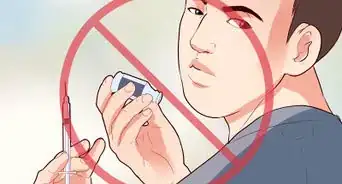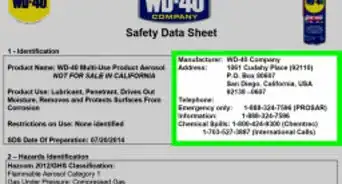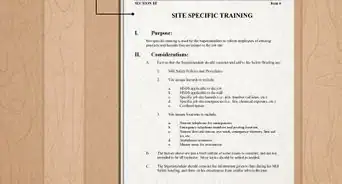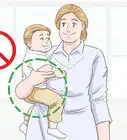This article was co-authored by wikiHow Staff. Our trained team of editors and researchers validate articles for accuracy and comprehensiveness. wikiHow's Content Management Team carefully monitors the work from our editorial staff to ensure that each article is backed by trusted research and meets our high quality standards.
There are 9 references cited in this article, which can be found at the bottom of the page.
This article has been viewed 14,369 times.
Learn more...
Identifying hazards is essential to preventing injuries at the workplace. It is also an important part of keeping your workplace in compliance with health and safety laws. You can identify workplace hazards by reviewing inspection and injury reports, soliciting feedback from employees, and seeking the assistance of professional health and safety experts from outside your company. Using these methods will help you protect workers at your workplace from potential harm.
Steps
Carrying Out an Internal Risk Assessment
-
1Review safety information about products in your workplace. Review the operating manuals for all equipment and machinery used in your workplace. Also, collect information included in Safety Data Sheets (SDS) for all chemicals that are present in your workplace.[1]
- Don’t forget to look over the owner’s manuals for computers and other common electronics, which will also include information about hazards associated with their use.
-
2Collect information from inspection and injury reports. Workers’ compensation reports, inspection reports from insurance carriers and government agencies, and workplace incident reports will contain information useful to your workplace risk assessment. Look through these reports and take special note of any patterns of frequently-occurring injuries and illnesses among employees.[2]
- The medical records of employees (with personal identifying information redacted) may also be helpful in discovering patterns of injury.
Advertisement -
3Set up formal processes for employees to report hazards they see. Send out surveys to receive input from workers. Set up a safety and health committee of employees to discuss and review workplace hazards, and keep detailed minutes of committee discussions to keep an up-to-date record of your findings.[3]
- Have employees play an active role in regular safety inspections of work areas, equipment, and operations.
- Consult workers before making any major changes to the workplace, including: rearranging workstations, reorganizing operations, or introducing new equipment. Ask them to help you identify potential hazards that might emerge.
- Visit https://www.osha.gov for more information about how to train employees to identify and analyze hazards in the workplace.
-
4Conduct regular inspections of the workplace. New hazards can enter the workplace as equipment and tools become worn over time and as employees enter and leave. During regular inspections, be sure to inspect all operations, equipment, and facilities.[4]
- Remember to inspect any vehicles that you use at your workplace, including passenger vehicles.
- Create a checklist of different types of hazards to look out for during your inspection, including: ergonomic problems, trip hazards, electrical hazards, equipment operation, fire protection, etc.
- Take photos and videos of hazardous conditions to keep a visual record, which you can then use when coming up with solutions to the problems or training employees to identify hazards.
-
5Investigate workplace incidents thoroughly to identify hazards. Conduct a thorough review of all illnesses, close calls, and injuries that occur in your workplace. You can prevent future accidents from happening by finding out the root causes of these incidents.[5]
- Create an investigative plan and procedure ahead of time, so that you can begin investigating an incident as soon as possible.
- Designate and train a lead investigator and investigative team, clarify lines of communication, and prepare any equipment and supplies that the investigator will need.
- Make sure the investigation team includes both managers and workers.
Seeking Outside Assistance
-
1Collect information published by relevant government agencies. The US Department of Labor, the Occupational Safety and Health Administration (OSHA), the Centers for Disease Control and Prevention (CDC), and other federal and state agencies regularly release information online and in publications that may help you identify hazards in your specific workplace.[6]
- Look at the Safety and Health Program Management Guidelines published by OSHA, for example, for helpful information about how to set up an effective safety and health system in your workplace.
- If you live in the European Union, visit https://osha.europa.eu/en to access health and safety publications, an online risk assessment tool, and other useful information about workplace hazards.[7]
-
2Consult other outside groups that might have relevant information. Insurance companies, your local fire department, or private safety and health consultants may be able to provide you with detailed information and data about hazards in your workplace. Labor unions and worker advocacy groups may also be able to shed light on common hazards encountered by workers in industries like yours.[8]
- If employees in your workplace engage in complex processes, seeking out safety and health experts can be especially useful.
-
3Make use of OSHA’s On-Site Consultation Program if you’re in the USA. If your workplace is a small- or medium-sized business, you can request a free safety and health consultation from OSHA. The OSHA consultant will inspect your workplace and give you a detailed written report with information about existing and potential hazards.[9]
- The OSHA consultant will not issue a penalty or citation if they find a hazard at your workplace, but you will expect you to put safety measures in place as soon as possible.
- The OSHA consultant will also not share the findings of the final report with OSHA inspection staff.
- This consultation service is available to companies with fewer than 250 employees at a worksite and fewer than 500 companywide.
- If you live outside the USA, look for a similar program offered by the government in your country.
- Businesses in the United Kingdom, for example, can search for a safety and health consultant in the Occupational Safety and Health Consultants Register (OSHCR): https://www.oshcr.org.[10]
References
- ↑ https://www.dol.gov/general/topic/safety-health
- ↑ https://www.ccohs.ca/oshanswers/hsprograms/risk_assessment.html
- ↑ https://www.osha.gov/safety-management/hazard-Identification
- ↑ https://www.osha.gov/shpguidelines/hazard-Identification.html
- ↑ https://employsure.com.au/guides/workplace-health-and-safety/accident-records/
- ↑ https://www.osha.gov/shpguidelines/hazard-Identification.html
- ↑ https://osha.europa.eu/en
- ↑ https://www.osha.gov/Publications/osha3071.pdf
- ↑ https://www.osha.gov/dcsp/smallbusiness/consult.html




































































Medical Disclaimer
The content of this article is not intended to be a substitute for professional medical advice, examination, diagnosis, or treatment. You should always contact your doctor or other qualified healthcare professional before starting, changing, or stopping any kind of health treatment.
Read More...